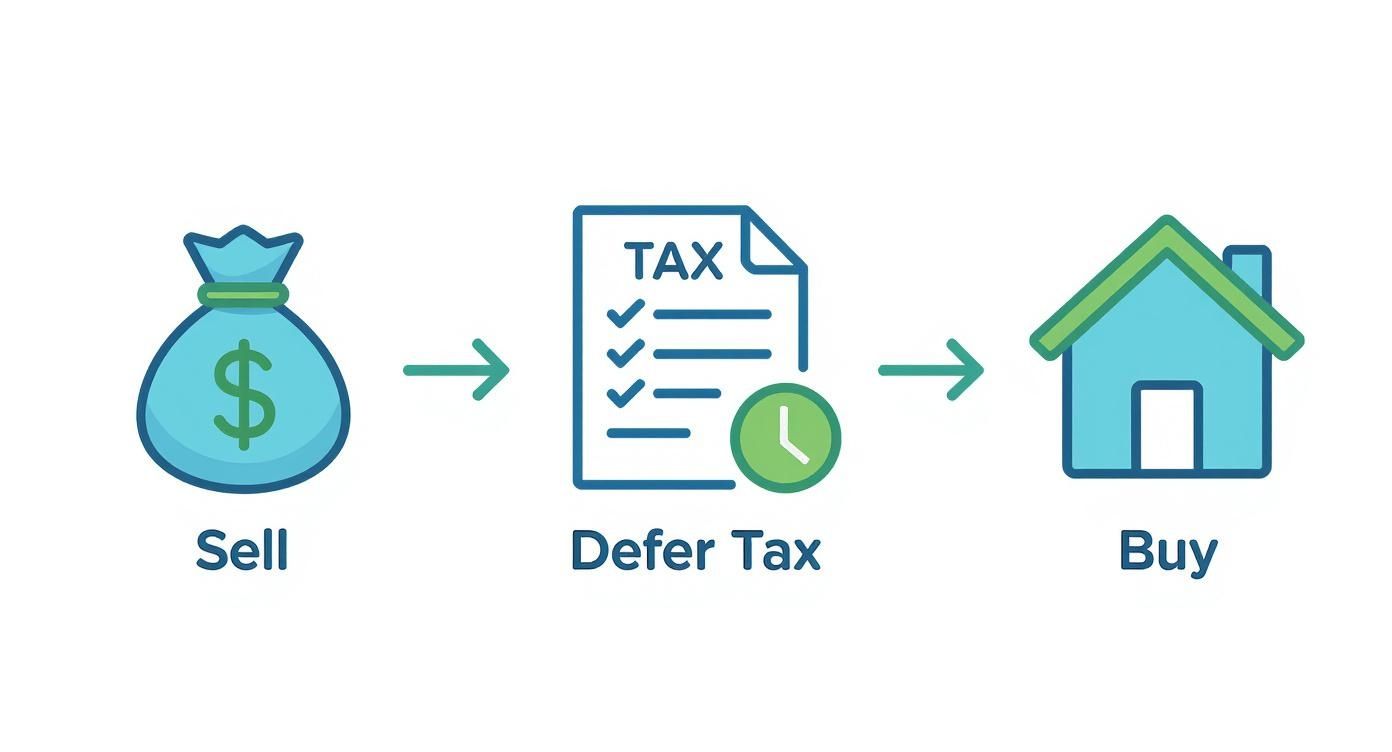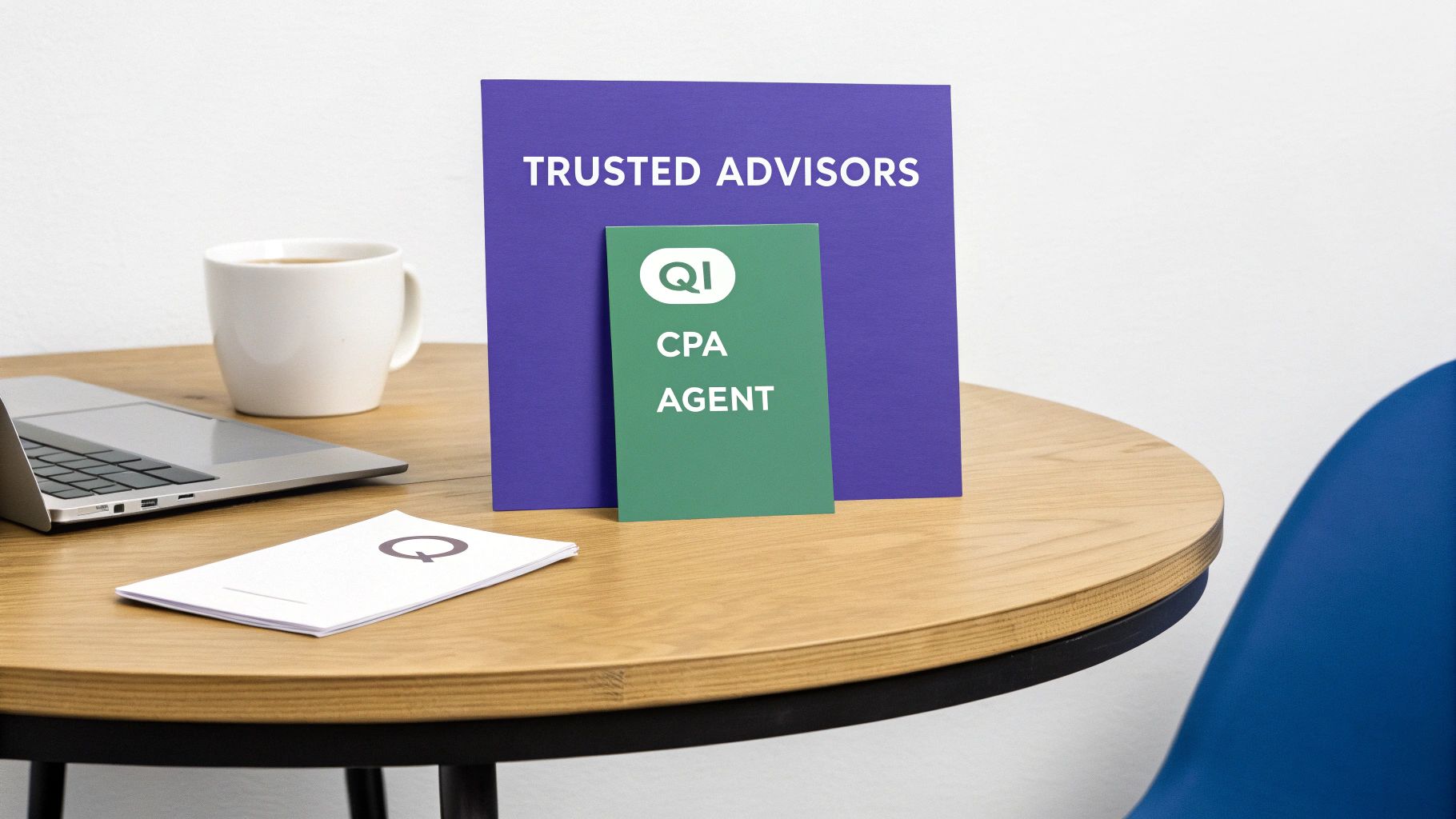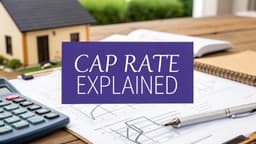If you’re a real estate investor, you’ve probably heard people talk about the 1031 exchange. It’s one of the most powerful tools in the playbook, letting you defer capital gains taxes when you sell one investment property and buy another.
This strategy, named after Section 1031 of the IRS code, is the key to keeping your equity working for you instead of handing a big chunk of it over to the government after a sale. Getting this process right is fundamental to growing a real estate portfolio efficiently.
What Is a 1031 Exchange and Why Does It Matter?
At its heart, a 1031 exchange is a wealth-building strategy. It lets you move from one investment property to another without having to pay taxes on your profits right away. You’re essentially hitting the pause button on your tax bill.
Instead of selling a rental and immediately owing capital gains, you roll 100% of the proceeds into a new, similar investment. This keeps your capital intact, allowing you to trade up for larger or more valuable properties and grow your portfolio much faster.
The key here is tax deferral, not complete tax avoidance. By continuously exchanging properties, you can push that tax bill down the road for years, sometimes indefinitely. For many investors, the goal is to hold onto the properties until they pass them to their heirs, who may benefit from a stepped-up basis. This strategic deferral is precisely why so many successful investors master the 1031 exchange.
The Power of Keeping Your Capital at Work
One of the most misunderstood parts of a 1031 exchange is the "like-kind" requirement. It's way more flexible than it sounds. You don’t have to swap a duplex for another duplex.
You could exchange a single-family rental for a small commercial building, trade raw land for an apartment complex, or even swap an Airbnb for a long-term rental. The only real rule is that both properties must be held for investment or business use.
This flexibility creates a ton of strategic options for investors:
- Diversify Your Portfolio: Trade a residential property in a flat market for a commercial building in a high-growth area.
- Boost Your Cash Flow: Sell a high-maintenance, low-rent property and buy a newer building with better returns.
- Consolidate Your Holdings: Combine several smaller properties into one larger, more efficient asset.
- Relocate Geographically: Move your investments to a different state or city without taking a tax hit.
This visual breaks down the basic flow: sell your property, put the tax event on hold, and then reinvest every dollar into a new asset.

This process is what allows savvy investors to compound their wealth over time, using their full capital to generate momentum.
A Long History of Empowering Investors
The 1031 exchange is hardly a new tax loophole. Its roots go all the way back to the Revenue Act of 1921, and it was designed from the start to encourage reinvestment and keep the real estate market moving.
A major turning point came in 1979 with the landmark Starker court case, which officially legitimized the "delayed exchange." This was huge. It meant investors could sell their property first and then have time to find a replacement, making the whole process far more practical for the average person. By 2021, these exchanges were supporting an estimated $7.5 billion in investment and nearly one million jobs.
A 1031 exchange is a powerful tool designed to defer capital gains tax, and understanding how to reduce capital gains tax is crucial for any investor.
This isn't just a strategy for big corporations; it’s a go-to for individual investors focused on long-term wealth. The ability to grow a portfolio without taxes dragging you down at every transaction is a massive advantage. It frees you up to make smart moves based on market opportunities, not tax fears, which ultimately creates a healthier real estate market for everyone.
Mastering the Critical 1031 Exchange Timelines

If there's one part of a 1031 exchange you absolutely cannot get wrong, it’s the timelines. These IRS deadlines are set in stone. Miss one by a single day, and the whole exchange is off, leaving you with a massive—and entirely avoidable—tax bill.
The clock starts ticking the second you close the sale on your relinquished property. From that moment, two critical countdowns begin at the same time. Let's break them down.
The 45-Day Identification Period
First up is the 45-day identification period. You have exactly 45 calendar days to formally identify potential replacement properties. This isn't just about browsing listings; you have to deliver a written, signed list of specific properties to your Qualified Intermediary (QI).
This 45-day window is notoriously tight, especially when you’re hunting for the right deal in a competitive market. It’s why experienced investors start their search long before their old property is even under contract. You want a shortlist ready to go so you can hit the ground running the moment that clock starts.
This is where a specialized network makes a world of difference. An agent who lives and breathes short-term rentals and the 1031 process, like those in the Chalet network, can be your secret weapon. They can bring you pre-vetted deals, including off-market opportunities, shaving precious days off your search.
Key Takeaway: The 45-day identification period is an all-or-nothing deadline. There are no extensions for weekends or holidays (unless a federal disaster is declared). Preparation isn't just a good idea; it's everything.
Once you submit your list to your QI, it's pretty much locked in. You can change it as many times as you want within the 45 days, but after midnight on day 45, your choices are final. This makes understanding the identification rules absolutely critical.
Navigating the Three Identification Rules
You have to play by one of three specific rules when you create your identification list. The right choice really depends on your strategy and how many properties you’re targeting.
-
The Three-Property Rule: This is the go-to for most investors because it’s simple and effective. You can identify up to three potential replacement properties, and their value doesn't matter. You only need to close on one of them to complete the exchange. It offers a great balance of flexibility without being overly complicated.
-
The 200% Rule: This rule lets you identify more than three properties, but with a major string attached. The total fair market value of all properties on your list can’t exceed 200% of what you sold your property for. So, if you sold a property for $500,000, the combined value of all your identified replacements can't top $1 million.
-
The 95% Rule: This is the high-risk, high-reward option and is rarely used. You can identify as many properties as you want, but you must close on at least 95% of the total value of everything you identified. If you identify $2 million worth of properties, you have to acquire at least $1.9 million of them. If even one small deal falls through, it could blow up your entire exchange.
The deadlines in a 1031 exchange are strict and unforgiving. Here's a clear breakdown of what you need to do and when.
1031 Exchange Critical Deadline Breakdown
| Milestone | Deadline | Key Action Required |
|---|---|---|
| Identification Period | 45 days from closing on the relinquished property. | Submit a signed, written list of potential replacement properties to your Qualified Intermediary. |
| Closing Period | 180 days from closing on the relinquished property. | Close the purchase on one or more of the properties you identified within the first 45 days. |
Remember, these two periods run concurrently. Missing either deadline will invalidate the exchange and trigger your tax liability.
The 180-Day Closing Period
The second critical deadline is the 180-day closing period. You must acquire and close on your new replacement property (or properties) within 180 days of selling your original one.
It’s crucial to understand that the 180-day clock runs at the same time as the 45-day clock. You don't get 45 days plus another 180. You get a total of 180 days for the entire process, with the identification happening in the first 45.
While six months might sound like a long time, it can fly by. This period is for conducting due diligence, securing financing, and navigating the entire closing process. Any unexpected delays with inspections, appraisals, or title work can eat up your timeline fast, adding a ton of stress as that 180-day deadline looms. Don't get complacent.
Building Your Professional 1031 Exchange Team

Let's be blunt: attempting a 1031 exchange on your own is like trying to perform surgery after watching a YouTube video. It’s incredibly risky and almost guaranteed to end badly. This isn't just another real estate deal; it's a complex legal and financial maneuver that absolutely demands a team of specialized pros.
Trying to save a few bucks by cutting corners here is a classic rookie mistake. A single misstep could invalidate your entire exchange, leaving you with a tax bill for hundreds of thousands of dollars. Your success truly hinges on the expertise of the people you hire. Think of it as assembling your personal advisory board—each member plays a critical, distinct role in protecting your investment.
The Non-Negotiable: Your Qualified Intermediary
First up, and most importantly, you must hire a Qualified Intermediary (QI). This isn't a suggestion; it’s a non-negotiable IRS requirement. The whole point of a 1031 exchange is that you, the investor, never have "constructive receipt" of the cash from your sale.
If that money touches your bank account for even a second, the exchange is blown. The QI acts as a neutral, third-party stakeholder, holding your funds in a secure escrow account from the moment you sell until you close on the new property. Their involvement is what legally makes it a tax-deferred "exchange" instead of a taxable "sale and purchase."
But a great QI does more than just hold your cash. They are the project manager for your entire exchange. They prepare all the necessary legal documents, make sure your identification forms are filed correctly, and keep you on track with every critical deadline. A seasoned QI has seen it all and will help you sidestep common pitfalls that could jeopardize everything.
How to Choose a Reputable Qualified Intermediary
Not all QIs are created equal. The industry is largely unregulated, so the burden is on you to do your homework. A surprisingly low fee can be a major red flag for inexperience or, worse, inadequate security for your funds. This is one area where you don't want to bargain hunt.
When you're interviewing a potential QI, here are the questions you need to ask:
- How are my exchange funds secured? Ask specifically about their fidelity bonds, errors and omissions insurance, and whether funds are held in segregated, FDIC-insured accounts.
- How many exchanges have you facilitated? You're looking for a firm with a long, proven track record, not a company that just added QI services last year.
- Who is on your legal and accounting team? Top-tier firms have in-house experts ready to navigate complex situations.
- Can you provide references? A confident and capable QI will have no problem connecting you with past clients or real estate professionals they’ve worked with.
Crucial Insight: The security of your funds should be your absolute top priority. With real estate fraud becoming more common, a QI’s security protocols—like requiring verbal confirmation for all wire transfers—are essential safeguards for your capital.
Assembling Your Supporting Cast
Beyond the QI, you need a team that gets the unique pressures and breakneck pace of the 1031 timeline. Your neighborhood residential real estate agent or a generalist CPA probably doesn't have the specific experience needed to guide you effectively.
Here are the other key players you need on your team:
- An Exchange-Savvy Real Estate Agent: You need an agent who understands the urgency of the 45-day identification period. They should have a network to help you find off-market deals and know how to write offers with 1031-specific language. Platforms like Chalet are designed to connect investors with agents who specialize in STRs and 1031 exchanges, which can save you precious time.
- An Experienced Title Company: The title or escrow company has to be familiar with the QI's role and the specific closing procedures for an exchange. They’ll work directly with your QI to ensure funds are transferred correctly and you never take constructive receipt.
- A Knowledgeable CPA or Tax Advisor: Your CPA is vital for both planning and compliance. They can advise you on the tax implications, help you calculate any potential "boot" (taxable profit), and make sure you properly report the transaction on your tax return using IRS Form 8824.
Executing a Flawless 1031 Exchange Process

This is where the rubber meets the road—turning all that planning into a tangible, tax-deferred outcome. A 1031 exchange is a methodical process. Knowing the steps ahead of time transforms it from something stressful into a clear path for portfolio growth. Let's walk through the entire journey, from selling your current property to closing on the new one, making sure every move is compliant.
Setting the Stage Before You Even Sell
Your exchange journey actually begins before your property even hits the market. One of the most critical—and often missed—first steps is to add a cooperation clause to your sales contract. This is simple language that formally notifies the buyer of your intent to perform a 1031 exchange.
Don't worry, this clause doesn't cost the buyer a dime or complicate their side of the deal. What it does do is contractually obligate them to cooperate with your exchange, like signing documents that direct the closing agent to wire your proceeds straight to your Qualified Intermediary (QI). Without it, you're at the mercy of a buyer who might delay things or refuse to cooperate, jeopardizing the whole exchange right out of the gate.
Bringing Your Qualified Intermediary into the Fold
Once you have a signed sales contract on your relinquished property, it's go-time. You'll formally engage your QI by signing an exchange agreement, which officially establishes their role as the facilitator. At this point, your QI opens a secure, segregated escrow account just for your exchange funds.
From this moment on, your direct access to the money is cut off. To avoid what the IRS calls constructive receipt—having control over the funds—the proceeds must flow directly from the closing agent to the QI's account. If that cash touches your personal or business bank account, even for a minute, the exchange is busted. The tax deferral is lost.
A Real-World Scenario: Trading a Duplex for a Commercial Building
Let's make this real. Say you're selling a duplex for $750,000. After paying off a $250,000 mortgage and $40,000 in closing costs, you're left with $460,000 in net proceeds. That entire amount gets wired directly to your QI.
The moment that transfer happens, your clocks start ticking: 45 days to identify potential replacement properties and 180 days total to close on one.
You've already been working with an agent from the Chalet network and have your eye on a small commercial building listed for $1.1 million. On day 25, you formally identify this property and two backups with your QI, well within the 45-day window.
Due Diligence and Closing on the New Property
With your target property identified, the focus shifts to due diligence. This is where that 180-day closing window really matters. You'll need to move efficiently to:
- Secure Financing: You have to replace both the equity ($460,000) and the debt ($250,000) from the old property. Since the new building costs $1.1 million, you'll need a new loan for at least $640,000 to defer all your taxes.
- Conduct Inspections: This is your standard physical inspection, but for commercial properties, it might also include environmental assessments and a thorough review of tenant leases.
- Review Title and Survey: Your title company will do its work to ensure the property has a clean title, free of any liens or claims.
Once your loan is approved and due diligence is cleared, your QI steps in to coordinate the closing. They will wire your $460,000 in exchange funds directly to the closing agent to finalize the purchase. You never touched the money, and the IRS's strict requirements have been met.
Watch Out for "Boot"
What happens if you don't reinvest everything? Any cash you receive from the exchange is called cash boot, and it's taxable. For instance, if you decided to only use $400,000 of your exchange funds and pocketed the other $60,000, that $60,000 is now subject to capital gains tax.
Likewise, taking on less debt on the new property than you had on the old one creates mortgage boot, which is also taxable. This is exactly why the "trade up" principle is so critical—you must acquire a property of equal or greater value to achieve full tax deferral.
Key Insight: The goal in any 1031 exchange is zero boot. Meticulous planning with your CPA and QI before you even list your property is the best way to structure the deal to avoid any surprises or taxable events.
Despite their clear benefits, 1031 exchanges have sometimes been misunderstood by policymakers. However, the data confirms they're a vital tool for investors of all sizes. A study analyzing over 816,000 transactions found that like-kind exchanges accounted for 10% to 20% of all commercial real estate deals, with a median sales price of $1.1 million. This shows that these exchanges aren't just for huge corporations; they're a mainstream strategy that facilitates investment across the entire market. You can learn more about the findings on 1031 exchange participants.
Successfully navigating this process comes down to following the rules and leaning on your expert team. From the initial contract language to the final wire transfer, every step is designed to protect your tax-deferred status and keep your capital working for you.
Avoiding Common Pitfalls and Using Advanced Strategies
Knowing the rules of a 1031 exchange is one thing. Actually executing one without a costly mistake is another. The real challenge lies in navigating the finer points and avoiding the common slip-ups that can blow up your transaction and leave you with an unexpected tax bill.
One of the easiest traps to fall into is taking constructive receipt of your funds. It’s a simple mistake with huge consequences. If the proceeds from selling your property touch your personal or business bank account—even for a second—the exchange is toast.
This is exactly why a Qualified Intermediary (QI) is a non-negotiable part of the deal. They act as a legal firewall, holding your funds so you never technically receive them.
Another frequent misstep is failing to replace both your equity and your debt. To completely defer your taxes, the property you buy must be of equal or greater value than the one you sold. This means you have to roll over all the cash proceeds from the sale and take on the same amount of mortgage debt, if not more. If you come up short on either, you’ll have taxable "boot."
Going Beyond the Basics with Sophisticated Techniques
Once you get the hang of a standard delayed exchange, a whole world of more advanced strategies opens up. These aren't for beginners, but for seasoned investors, they provide the flexibility to tackle unique situations and pounce on opportunities that a straightforward exchange just can't handle.
These scenarios aren't your everyday deal, but just knowing they exist can unlock new investment possibilities. They demand serious coordination with your professional team—especially your QI and tax advisor—to pull off correctly.
Here are a few advanced strategies worth knowing about:
- Reverse Exchanges: What if you find the perfect replacement property before you've even listed your current one? A reverse exchange lets you lock it down. Your QI, through an Exchange Accommodation Titleholder (EAT), acquires the new property for you and holds it for up to 180 days while you get your old property sold.
- Improvement or Construction Exchanges: This is a powerful one. It lets you use your exchange funds to build or make significant improvements on your new property. For instance, you could buy a fixer-upper for $800,000 and use another $300,000 from your exchange proceeds to fund a massive renovation, all before the property is officially titled in your name.
- Partnership Exchanges: Things get tricky when you have an LLC with multiple partners, and some want to cash out while others want to exchange. Strategies like the "drop and swap" or "swap and drop" can help individual partners go their separate ways with their own 1031s, but the structuring has to be absolutely perfect to satisfy the IRS.
The Economic Footprint of 1031 Exchanges
The sheer volume of these transactions shows just how vital they are to the real estate economy. Between 2008 and 2017 alone, investors completed over 500,000 exchanges, moving around $1.6 trillion in real estate assets. This isn't some obscure tax loophole; it's a core mechanism that keeps capital flowing, allowing investors to trade up and improve their portfolios.
Expert Tip: Advanced exchanges are not a DIY project. They require meticulous planning and a highly experienced QI. Always map these strategies out with your team well ahead of time to make sure they align with your goals and to navigate the complex legal steps involved.
Ultimately, mastering both the common mistakes and the more advanced techniques elevates the 1031 exchange from a simple tax tool to a powerful engine for building wealth. Other countries have similar mechanisms, like Australia's Capital Gains Tax Rollover Relief for business assets, which just goes to show how critical these investment-focused tax provisions are on a global scale.
Common Questions About 1031 Exchanges
Even with a perfect plan on paper, real-world questions always come up when you're getting ready for a 1031 exchange. It’s a process with a lot of moving parts, and it's totally normal to have questions about your specific situation. Let’s walk through a few of the most common ones I hear from investors.
Can I Use a 1031 Exchange on My Primary Residence or Vacation Home?
The short answer is no, you generally can't. A fundamental rule of Section 1031 is that both the property you sell and the one you buy must be used for business, trade, or investment. Your primary home just doesn't fit that description.
However, a vacation home can be a different story. It's sometimes possible to convert a second home into a qualifying investment property. The key is to limit your personal use and rent it out at fair market value for a good chunk of time—usually at least two years—before you kick off the exchange.
What Happens if My Exchange Fails?
This is the scenario everyone wants to avoid. If you miss the strict 45-day identification deadline or the 180-day closing window, the exchange is busted. When that happens, your deal is simply treated as a regular property sale.
The fallout? You’ll owe capital gains taxes on all the profit, just as if you never even tried to do an exchange. This is exactly why careful planning and working with an experienced team is non-negotiable. The financial stakes are just too high to wing it.
Important Reminder: The IRS is incredibly strict about these deadlines. One of the only times they grant an extension is for a federally declared natural disaster that directly impacts you or the properties involved.
Does Seller Financing Affect a 1031 Exchange?
Yes, and it can make things a lot more complicated. If you offer seller financing, the promissory note you receive from the buyer is considered "boot" by the IRS. Why? Because a note isn't a "like-kind" property.
This means the value of that note becomes taxable income in the year you sell. While there are some advanced strategies to deal with this, like selling the note to a third party before your exchange period ends, it adds another tricky layer. Always talk through any seller financing ideas with your Qualified Intermediary and CPA before you agree to it.
Can I Change Ownership or Vesting During an Exchange?
This is a classic mistake. The IRS has what's called the "same taxpayer rule," which means the same person or entity that sells the old property must be the one to buy the new one.
For instance, if you sell a property titled only in your name, you have to buy the replacement property in your name alone. Trying to add your spouse or switch from your personal name to an LLC mid-exchange will blow up the entire deal. Any changes to the title or vesting need to happen long before or long after the exchange is finished—never during.
Executing a successful 1031 exchange requires the right strategy and the right team. At Chalet, we connect you with expert agents and provide the data-driven tools you need to find and analyze the perfect replacement property. Explore our network and resources at https://www.getchalet.com to make your next investment move with confidence.






